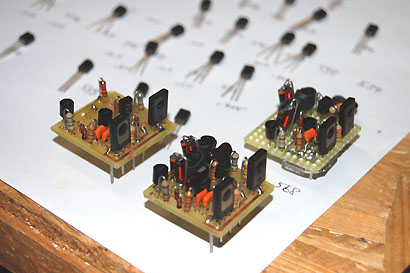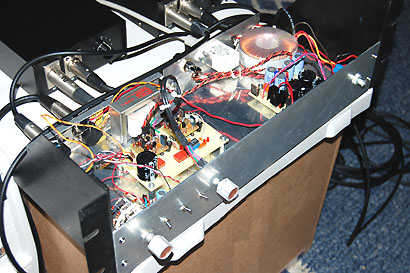burdij
Well-known member
I was thinking that might be a possiblity, but how do you produce a null signal with a method that itself is free of TIM distortion?
The observer affects the observed.
The observer affects the observed.
The SMPTE (Society of Motion Picture and Television Engineers) standard specifies a two-sinewave test signal consisting of a low-frequency, high-amplitude tone linearly combined with a high-frequency sinewave at 1/4 the amplitude of the low-frequency tone. The SMPTE specification calls for 60Hz and 7kHz as the two sinewaves. When a non-linear device is subjected to a two-tone test signal, intermodulation products appear as sidebands around the high-frequency tone. The percentage intermodulation distortion is defined as the percentage of amplitude modulation, represented by the second and third order pair of sidebands, of the high-frequency signal. Second order sidebands around the high frequency tone are spaced at a frequency equal to the low-frequency tone (FH ± FL). Third order sidebands are spaced at twice the low-frequency tone or FH ± 2FL. (FH and FL correspond to the highfrequency and low-frequency tones, respectively.2)
CCIF intermodulation distortion testing consists of using two equal-amplitude, high-frequency signals spaced closely in frequency. Signals used for test data presented include 13kHz and 14kHz. The audio analyzer measures only the amplitude of the difference tone or low-frequency product resulting from the two high-frequency test signals. Here, the percentage intermodulation distortion is defined as the percentage of amplitude modulation which the low order or difference signal (FH - FL) represents on the high-frequency signals.
burdij wrote:
2. The gain block must have a fairly high slew rate at a moderately high gain so that it can achieve a good GBW for a significant number of harmonics of the fundamental of each intermingled wave in the wave "packet".
I didnt understand this one. Could you explain ?



NewYorkDave said:I've admired the several discrete op-amp designs that have been posted here and elsewhere. But being a minimalist at heart, and someone who does not consider himself an expert in design with discrete transistors, I wonder if good performance could be obtained with simpler circuits.
You need to be more clear about how you define "opamp". The working definition I have always heard involves 2 high impedance inputs, differential gain, etc etc. The classic LTP is the simplest way to execute that, especially with the low active device count constraint.thermionic said:edit - just answered my own question, so I'll rephrase it:
I am curious as to whether there have been many 'simple' opamps, i.e. with fewer than 5 transistors, that are unity gain stable and do not implement the LTP at the front.
J
So-called "current-feedback" opamps, "CF-opamps", have a "high-impedance" (usually not-so-high anyway) and a low-impedance "input" node, used for the "feedback".thermionic said:edit - just answered my own question, so I'll rephrase it:
I am curious as to whether there have been many 'simple' opamps, i.e. with fewer than 5 transistors, that are unity gain stable and do not implement the LTP at the front.
J